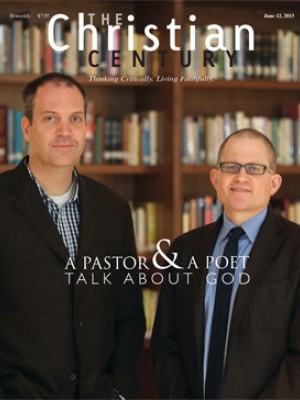Speaking Faithfully, by Jim Naughton and Rebecca Wilson
Call it the chicken-dinner problem. The last parish I served was a small one in a rural area. Approaching from the north, you would pass farm fields, a barn or two, some houses. At the edge of the cemetery, before you saw anything else about the church, you encountered a large, permanent sign advertising the congregation’s annual fund-raiser.
The leaders of the congregation understood that perhaps their church should be known for something more than grilled chicken, stuffing and desserts, no matter how delicious. But the dinner was a big event, and it was necessary. And so the sign stayed. To the extent that any unchurched neighbors thought about the congregation, they thought about the chicken dinner. They would stand in line for it every year. None of them ever thought our parish might have something else to offer.
Read our latest issue or browse back issues.
Jim Naughton and Rebecca Wilson come out of the Episcopal church, where the problem is more likely to be highbrow concepts like a robust baptismal ecclesiology. Yet their difficulties and those faced by my humble congregation boil down to the same question. How can churches and other religious institutions speak effectively to let the world know that something is happening with church people that they might want to be a part of?
Naughton and Wilson offer a simple answer: speak from the heart, do it creatively, and most of all, do it with humility and sensitivity to the needs of your audience. Or, as they put it, “Keep telling stories, keep making sacraments, keep inviting people to ‘come and see,’ keep making our communities appealing to those without and stimulating to those within.”
This book is not just another how-to manual to be ignored until the next time the church council gets interested in evangelism. Naughton and Wilson offer plenty of practical advice, with chapters on messaging and target audiences; on using online and print media, broadcasting and advertising; on crisis communications; and on making church facilities visible.
At its heart, however, Speaking Faithfully is theological, not technical: communication is proclamation. The way the church chooses to speak to the world reflects its faith. Naughton and Wilson remain upbeat throughout, and for the most part they avoid pointing out the failures they’ve seen. The implicit point is clear. Churches that do not figure out how to talk to those not already part of their community give a poor showing as disciples of Christ, a master communicator who used vivid, creative strategies to teach and bless the people he encountered.
Christians, of course, are called to do likewise. It makes no difference whether they are ordained. Laypeople will learn from this book that they can and should “bear witness to the Gospel of Jesus Christ that changes people’s lives.” The power to do so is not the province of highly trained specialists; it is a gift given to every member of the church empowered by the Holy Spirit. For that reason, I would have liked a fuller examination of how to implement communication strategies in resource-poor organizations. But very little of what the book presents is beyond the reach of the average congregation, and Naughton and Wilson add helpful suggestions for what is.
Their most consistent suggestion is simply to get out there and do it, because fewer and fewer people are willing to come into the church on their own initiative. “The church cannot assume it enjoys the institutional privileges it once did,” the authors write. “It cannot assume that most of the world thinks well of us, or cares much about what we do. We have to work harder, be more inventive and more entrepreneurial.”
In a long section on the spread of a story on “Ashes to Go,” Naughton and Wilson say that they have recounted the experience “not (solely) because it speaks to the importance of a well-integrated communications plan or a timely pitch to the mainstream media,” but because offering ashes to people on Ash Wednesday on a street corner “made our faith known to much of the country.” They quote Amy Frykhom’s blog post for the Christian Century on why taking ministry to the streets this way is important:
The idea is to bring the church, with its rites and symbols, to the people—not to force anything on them, but because forgiveness, repentance, introspection, a moment of connection and quiet are needed everywhere. Bishop Jeff Lee, of the diocese of Chicago, recalls a woman, who, upon receiving ashes from him said that she never imagined that “the church would come out here to us.”
She’s not alone. How to minister to her and the many like her is the problem—and the opportunity—to which Speaking Faithfully witnesses.






